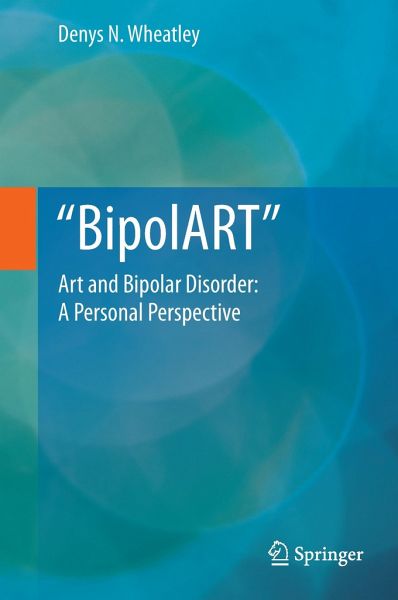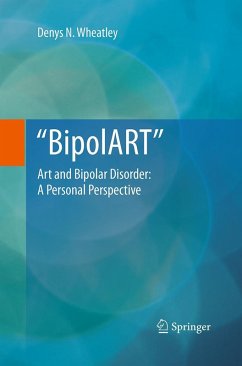it is abstract, and the main themes are biological, scientific, musical or geometric . The book has been produced to offer insight into the personality behind the pictures - a man in severe mental distress. The author/artist hopes that it may help others who experience bipolar disorder as they reflect upon the images, and also those who do not to understand it a little more.
I find many of the images incredibly beautiful. I love the most simple, black and white ones such as 'Grip Stand', 'Glassy Eardrop', and 'Draped Urn'. It's interesting to read about how these are produced, and how they evolve from a few doodled lines and squiggles into something whole and complete. And the coloured images are fantastic - some are so vibrant that they almost jump off the page! Check out 'Fantasy Birds', and the stunning 'Moons andSkulls'.
BipolART is full of interesting reflections on art, creativity and bipolar disorder, and some really useful insights are offered, such as the fact that it can be exhausting to play a musical instrument when you are severely depressed, not only because the ability to concentrate is affected, but also because depression can have an impact on motor co-ordination, so that a person becomes less dextrous.
I think that this is a beautiful and interesting book which is well worth having. Any royalties made from book sales will go to a mental health charity.
CAROLINE CARR, Dip Adv Hyp, Dip LC, BA (Hons),
Clinical Hypnotherapist
www.carolinecarr.com and www.mypartnerisdepressed.com email:
caroline@carolinecarr.com
Tel: +44 (0)7846208378 and +44 (0)1202 731385
Follow me on Twitter: @00CarolineCarr
Find me on Facebook: www.facebook.com/CarolineCarr.LetSunshineIn
[Caroline is the author of several self-help books, all published by White
Ladder Press.]
November 26, 2012
"A remarkable book. The author, a cell biologist, describes his experience with his mental ill health, and presents his marvellous doodles which have helped him. They are surprising. All this could also help those who suffer from bipolar disorder, particularly depression."
Lewis Wolpert [profwolpert@yahoo.com]: author of "Depression: a malignant sadness"November 22, 2012
"This book by Denys Wheatley is certainly unique in its content and presentation. Using a wide range of media and topics, the artwork reflects very strongly the workings of his (BP) mind. While a scientist by profession, he seems to me to be an artist by instinct. I recommend this book very highly, not only to many of those in the medical and healthcare professions, but also to the layman, as there are many who suffer the vicissitudes of mental disturbances."
Jim Clegg [jsclegg@ucdavis.edu]: Former Director, Bodega Bay Laboratory, University of California Davis4 November, 2012
"Combining his drawings with his (cell)-biological knowledge, Dr Denys Wheatley gives us a quite personalized perspective on the challenging condition, for patients as well as close family and sometimes friends, called bipolar disorder. Actually many famous artists, from Michelangelo to Vincent van Gogh may well have had the same or a similar condition (http://www.pendulum.org/information/information_famous_artists.html). Also, people who might not consider themselves artists but who had (and have) neurological diseases have come to use art as therapy, splendid examples of which can be seen in the La Collection de l'Art Brut in Lausanne (Switzerland). Where Dr. Wheatley's work distinguishes itself is that, although the titles of the work mostly refer to "outer" body constructs, consciously or not his work appears to reflect organic biological structuresreminiscent of his research in cell biology. Quite a few of his drawings reminded me of inner-ear structures, perhaps influenced by his work with cilia and related structures. Others brought to mind the nervous tracts of vertebrates and arthropods. His work demonstrates an interface between art and science, and anyone interested in studying the influence of the bipolar condition on artistic expression will find his work truly fascinating."
Bert Menco [bertmenco@northwestern.edu]; former Professor of Biology, Northwestern University, Chicago - established US artistNovember 27, 2012
"This delightful book comprises just 121 pages of main text, but in that short compass Denys Wheatley manages not only to convey much about bipolar disorder from the sufferer's point of view, but also to provoke the reader into pondering the nature of creativity in art and science. At the same time he contrives to entertain and please the eye. Wheatley draws in part on his long personal experience of extreme mood swings, making stimulating observations about the value of art (particularly doodling) as therapy, and in part on his profound and wide-ranging scientific knowledge, as well as his love of great paintings and music. The quality of his art work is well above 'amateur' standard, and the often abstract forms show the influence of his decades of research in (cell) biology, a fascination with geometry, the visual environment, and Europe's cultural heritage. In addition to the reflective chapters and the analytical comments on individual drawings and paintings, the author gives us a fascinating stage-by-stage guide to the process by which a doodle can grow from insignificant beginnings into an eye-catching piece of art. He almost tempted me to take up doodling, but I doubt whether I could create any end-product to match his.
It would have been all too easy for a book of this kind, the personal reflections of a'manic-depressive', to degenerate into navel-gazing and self-pity. But not for a single sentence does 'BipolART' commit that literary sin. Once I started to read the book I couldn't put it down; only the irresistible urge to linger on individual pictures, relishing their beauty and intricacy, retarded my progression from first page to last. This is a book that could be read for both pleasure and profit by psychologists, psychiatrists, art critics and philosophers interested in creativity, but above all by the interested non-specialist - the 'man on the Clapham omnibus', as Wheatley himself puts it. I recommend it warmly."
Paul Agutter: Editor-in-Chief, Theoretical Biology and Medical Modelling (BioMedCentral, London)November 30, 2012
BipolART is a very candid account of a bipolar suffers struggle to live with and in part overcome this disorder. Like deafness it is a hidden disease, many suffer "in silence". This book may not only be seen as one form of remedy for Bipolar suffers, but also as an alert to our fellow men that this IS a real illness and just as distressing, if not more so, than a tangible disease. Although we are in the 21
st century, the stigma of mental illness has not been properly shed. I applaud Dr. Wheatley for his openness and positive attitude on such a sensitive subject. I find his "Doodles" often complex, sometimes colourful, but always an innate sense of fun shines through even though most were done in the darkest of depressive episodes. This is indeed a good tool for relaxing and losing oneself in the production of art, no matter who you are. As a stained-glass specialist, I can see that some of the designs would make stunning stained-glass windows. The more science-based "doodles" are much more original and appealing than those influenced by other artists.
Jennifer-Jane Bayliss (janebayliss@btconnect.com); Stained glass masterartist















